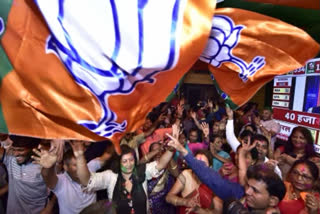New Delhi:The BJP juggernaut spearheaded by the astute political strategist Himanta Biswa Sarma continued its uninterrupted run for power in Assam, winning in 60 seats excluding the victories by its allies the Asom Gana Parishad (AGP) in 9 seats and the United People’s Party, Liberals (UPPL) in 6, staking its claim to power after securing a comfortable majority in the 126-member state assembly.
While there were strong rumours of an anti incumbent sentiment a couple of days before the first phase of polls commenced on March 27, the results have proved it to be a false alarm.
But the rumours jolted the BJP leadership into kinetic action and resultantly, it put it’s everything into Assam.
Seen as a gateway to the Northeast region, it is considered very important to retain grip on the region. Six of the region’s states have BJP or BJP supported state governments. Assam, Arunachal Pradesh, Manipur, and Tripura have BJP-headed governments while the BJP is a ruling partner in Meghalaya and Nagaland.
With Assam being the gateway to the Northeast, it is very important that the BJP retains power in the state so that the party’s grip on the entire region remains steadfast.
Also Read: As predicted, Assam sees a second saffron surge
To be fair, of all the five states, the BJP had the most realistic chance of a win only in Assam.
In retrospect, while the weaknesses of the opposition appear to be more glaring than the strength of the BJP, what made the BJP click this time?
The BJP had a development-centric agenda where populist measures like distribution of free rice, microfinance loan waiver scheme and direct benefit transfer made an impact. There is also a belief that infrastructure development became a priority.
On the other hand, the alliance of the Congress with the Badruddin Ajmal-led AIUDF proved to be the former’s undoing and the grand old party carried the albatross on its neck.
The BJP played the Ajmal card to the hilt reminding the voters of the imminent ‘civilisational danger’. The Upper Assam ‘oxomiya’ seemed to have bitten BJP’s bait. Reckless utterings by AIUDF leaders also queered the pitch.
There seemed to be no organic cohesion in the main opposition, nor any charismatic leader of Tarun Gogoi’s ilk to blend the two allies into one.
The opposition votes were divided and there was no proper coordination among the voters reeking of poor booth level management by the opposition. And it was here that the ‘polarising’ effort of the BJP played a big role.
The opposition failed to properly articulate burning issues such as price rise or the inadequate compensation in tea garden wages.
The strong sentiment against the Citizenship Amendment Bill (CAB) which had rocked almost the entire state in recent times could not be channelized and translated into votes. Nor did the Sixth Schedule issue find much traction in the electoral campaign.
In short, the 2021 Assam state polls will go down more as a collective failure of the anti-BJP opposition to cohesively put up an organic political entity than a pure strategic success by the saffron party.
